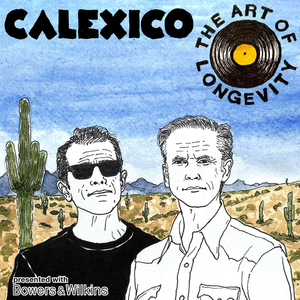
The Art of Longevity
The Song Sommelier

1 Creator

1 Creator
Uniquely honest conversations with famous and renowned musicians. We talk about how these artists have navigated the mangle of the music industry to keep on making great music and winning new fans after decades of highs and lows. We dive into past, present and future and discuss business, fandom, creation and collaboration. What defines success in today's music business? From the artist's point of view.
The Guardian: “Making a hit record is tough, but maintaining success is another skill entirely. Music industry executive Keith Jopling explores how bands have kept the creative flame alive in this incisive series”.

1 Listener
All episodes
Best episodes
Seasons
Top 10 The Art of Longevity Episodes
Goodpods has curated a list of the 10 best The Art of Longevity episodes, ranked by the number of listens and likes each episode have garnered from our listeners. If you are listening to The Art of Longevity for the first time, there's no better place to start than with one of these standout episodes. If you are a fan of the show, vote for your favorite The Art of Longevity episode by adding your comments to the episode page.

The Art of Longevity Season 3, Episode 2: Feeder
The Art of Longevity
01/11/22 • 66 min
When it comes to longevity, Feeder keeps coming back around, and the guitar-rock scene is all the better for it. It was back in January 2001 that “Buck Rogers” reached number five on the UK chart (the song remains a radio standard even in its 21st year). Grant Nicholas originally wrote the song to impress producer Gil Norton in the hope he would be persuaded to work with Feeder. Buck Rogers contains a big guitar riff and stream-of-consciousness lyrics about being jealous of his rival’s brand new Jaguar (with a CD player) and whatever else came into his drunken head. Including drinking cider from a lemon.
Having a bona fide top five hit was never going to put Grant Nicholas under any pressure to repeat the trick. Songs just pour out of him and while not all of them are as catchy as Buck Rogers, Nicolas knows his way around a melody and a soaring, anthemic chorus as well as any songwriter in the business. When we spoke on The Art Of Longevity I asked Grant how come he hasn’t often been asked to write for others (he has only a little, and I hesitate to suggest he could do more, not wishing to worry Feeder fans we’ll lead him astray). It remains an option, always.
Feeder may not be fashionable but they have made it through the music industry mangle - achieving chart success, playing arenas and having made a bunch of very good albums (with Comfort in Sound a genuine rock classic). These days it’s all about the joy of new songs and playing to the fans. Nicholas and his co-founder member/bassist Taka Hirose soldier on as Feeder through thick and thin, yet they operate with an enthusiasm and energy befitting of any up & coming rock band blossoming for the first time. Where a lot of their contemporaries have fallen by the wayside, Feeder stayed on the bus, and it turned out to be a magic bus!
Get more related content at: https://www.songsommelier.com/

1 Listener
1 Comment
1

The Art of Longevity Season 4, Episode 5: Calexico, with Joey Burns
The Art of Longevity
05/25/22 • 55 min
We spoke to Joey Burns on the eve of Calexico's recent European shows in Brussels and London. Calexico play bigger venues in Europe than they do on their home turf, despite inventing a sound that conveys that land so evocatively. Indeed, it was music journalist Fred Mills who captured the band’s sound so perfectly with just two words: “desert noir”. What a cool subgenre to have invented. Since most music writers lazily throw in all the various tex mex music flavours in describing Calexico’s sound, Joey is happy to clarify:
“We are connected more with mariachi and cumbia than say tex mex or tejano or norteño which has a different connection to a different tradition. For the most part we are mariachi, cumbia. I’ve never felt like I’ve mastered anything, but I’m lucky enough to play with some of those that have”.
Calexico is touring as a septet, with Burns and partner/drummer John Convertino accompanied by Sergio Mendoza, MARIACHI LUZ DE LUNA, upright bass virtuoso Scott Colberg and the brilliant guitar player and singer Brian Lopez. The set combines magical mariachi of the highest possible standard, yet when the band chooses to (as on the thrilling Then You Might See) they jam out extended plays of true sonic power in the style of Radiohead or James. In combining those elements the band’s singularity is astonishing.
I can usually pinpoint exactly how I discovered a new band of longevity and for Calexico it was a recommendation from the late, erudite Robert Sandall, BBC Radio 3 presenter of Late Junction and one time Head of PR for Virgin Records. He told me I must listen to Feast of Wire three times. He was very specific about it. I remain entirely grateful to Robert. There is nothing quite like a recommendation that sticks. Not only did that one tether me to Calexico for life, but the ‘listen three times’ rule is something I have adopted as a tactic in my own recommendations. I implore you, thrice discerning listeners. It is well-known that beautiful things often come in threes.
Get more related content at: https://www.songsommelier.com/

The Art of Longevity Season 2, Episode 1: KT Tunstall
The Art of Longevity
07/27/21 • 47 min
On the Art of Longevity Series II, Episode One, KT Tunstall tells me that albums can feel like a ‘flash in the pan’ despite all the work that goes into them. But albums like Wax (her latest, from 2018) will stick around in the ears for a long time to come.
KT Tunstall was the classic ‘overnight success’ i.e. ten years in the making, having busked her way around the St Andrews and Fife scenes since the mid 90s. It all ‘began’ with that performance of ‘Black Horse & The Cherry Tree’ on Jools Holland (2004) - an old fashioned breakthrough moment. As remarkable as she came across working with just the guitar and the delay pedal, she was simply doing what she had been for the previous 18 months - busking her way through it. Except this time, it was on UK national television on the only music show that mattered.
What followed was a version of the classic Art of Longevity career curve: the stratospheric rise, the pressure drop and the years of wrestling between her own creative instincts and the commercial demands of the industry. But through it all KT understood that the record labels' job is business, while what she does is make art, and that attitude has seen her navigate the industry mangle to come out the other side stronger, more rounded as an artist and, if you listen to Wax, still making platinum grade pop-rock. Meanwhile, KT will always be on the music scene thanks to those immortal songs from her debut. She has come a long way from the rainy streets of St Andrews to the arid canyons of Topanga. It seems like she has much further to go.
Get more related content at: https://www.songsommelier.com/

The Art of Longevity Season 2, Episode 5: Mew
The Art of Longevity
10/07/21 • 41 min
If one of the secrets to longevity in the music industry is simply taking your time, then Danish alternative rock band Mew are grand masters. Formed in 1995, the band took eight years before a major label deal came along, and with it, international success (the superb breakthrough album Frengers). It did not lead to a rush. Some 26 years into the band’s career, Mew has released just seven studio albums - one every four years. That’s not something Spotify would advocate as an operating model for bands these days, is it? It’s rare for a European rock band to breakthrough to an international audience and to have a career of real longevity (count them on one hand), but it is even rarer to be so damned cool about it!
Yet Jonas Bjerre is unfazed by any concept of FOMO - or the creator equivalent ‘FOBF’ - fear of being forgotten. In fact, when the band released their last LP ‘Visuals’ in 2017 just two years after the 2015 album ‘+ -’, Jonas’s overwhelming instinct was that fans were not expecting it.
Visuals plays from beginning to end like a stage musical, something I put to Mew singer Jonas Bjerre on the Art of Longevity. It may well have been the influence of Prefab Sprout and Paddy McAloon. When it comes to influences, Mew are true musical alchemists. While many ‘rock’ (as in guitar rock) bands have eclectic and ‘classic pop’ influences, very few can meld them successfully into their own sound. Perhaps it’s because of the restrictive formulas of rock, or not wanting to upset fans. Not so with Mew. One minute they’re all off-kilter time signatures and dissonant guitar noises, the next, soaring, beautiful and catchy pop - nicely topped off with Jonas’ angelic vocals.
Listen in to hear a truly unique way of working. Jonas and Mew don't rush anything, but the results are often sublime. It is good to hear that the band is talking about another project - even if it is early days and Jonas would also like a break before. Sometimes as a music fan, patience is a virtue and the rewards are all the sweeter.
Get more related content at: https://www.songsommelier.com/

The Art of Longevity Season 2, Episode 4: Los Lobos
The Art of Longevity
09/17/21 • 60 min
When I sat down with Steve Berlin, the Los Lobos sax player and de facto spokesperson, I was a little more than intrigued. To most people around the world - outside of North America anyways - Los Lobos remain the La Bamba band. How wrong we are.
There is a very common thread with the artists we’ve had on the show - and with longevity - every one of the artists (except so far, Laura Veirs and Maximo Park) had a very big song: James, Turin Brakes, Gary Numan, KT Tunstall...
But Los Lobos is the most extreme example of a longevity outfit with a big song - the band had no other hits at all. Taking nothing away from La Bamba - a fine record and a justified number one in ten countries back in 1987. But stop right there. Try Googling, as I did, “Los Lobos, greatest American rock band” and there are more than a few articles examining that hypothesis, for good reasons. Built around the soulful songs of drummer Louis Perez and lead vocal and guitar player David Hidalgo (throw in a few rollicking rockers by Cesar Rosas) Los Lobos make solid, classic Americana-rock, but from a Latin point of view - and a deep rooted connection to traditional Mexican music: cumbia, boleros and norteños. Finally, throw the city of LA into the mix and you have the Los Lobos agenda, musically speaking.
It’s not surprising that Los Lobos have made a record of cover versions of seminal LA songs (The Beach Boys, Jackson Browne, War, Percy Mayfield) but what is surprising is how long it took to come up with the idea to do just that.
“We have a sixth sense of when to do stuff, somehow the muse talks to us. It's important for us to have a boundary - an idea - not just another Los Lobos record. The main thing for us is longevity and being able to do what we do and to answer to nobody other than ourselves, we have such gratitude for that. We have no obligation other than to move forward with our music”.
Now that is an agenda for lasting the distance. Yet Steve and I have fun with one idea - for Los Lobos to soundtrack a Netflix (or HBO, or AMC) production of Jaime Hernandez' genius Mexicana soap opera Love & Rockets. What a collaboration that would be.
Somebody get Ted Sarandos on the line...it’s Steve Berlin calling, from Los Lobos...
Get more related content at: https://www.songsommelier.com/

The Art of Longevity Season 2, Episode 3: Fink
The Art of Longevity
08/30/21 • 69 min
On The Art of Longevity, Fin Greenhall explained the ideas behind Fink's new project IIUII: an acoustic retrospective of some of the band's (and fans) favourite, biggest songs.
“I’m a better singer now than I was in 2005, so I feel I can do a better job of singing these songs. As a band we are much more loose, grounded and subtle than we used to be - comfortable with who we are”. As such, the idea behind the project is to do a better job of those songs by bringing experience to bear as the songs are revisited and reinterpreted. “I love the fact that when you write a song, that song exists, but then over time it can be dressed many different ways”.
Indeed, we discuss one of the most intriguing concepts in music today - that of making a song something more than simply finite recording. A song should never be set in stone, something Fink seems to understand acutely. Their last studio album, ‘Bloom Innocent’, is a case in point - the band has since released two further versions of the record - an acoustic work and a “Horizontalism” edition (Fink has even sub-branded it’s remix versions under the Horizontalism concept). The IIUII album is the first acoustic retrospective of the whole catalogue, yet already there has been some orchestral versions of some of these songs, in the superb 2013 release ‘Fink Meets The Royal Concertgebouw Orchestra’.
While the music industry is littered with ex-musicians and creatives now working on the management side, Fin Greenhall did the opposite - spending nearly half a decade in the offices of labels (hence ‘Biscuits’), figuring out how the industry worked (and working his way up from office skivvy to marketing manager). He flipped from being an executive to a creator - but seems to have picked up on some clever marketing angles along the way. Along with these reworked versions, the 2015 short film “Less Alone” was one of the first examples of an artist manifesto I’d ever seen expressed through the short documentary format. It’s a nice exercise in artistic branding. That might just have something to do with Fin’s thought processes.
Another example is the track selection for IIUII. Fin told The Art of Longevity that: “we went back over the streaming stats and thought about our live shows over the years and picked the songs that the fans feel really represent us”. Savvy indeed, now that is how creatives can use industry data simply and effectively.
Considered decisions have been part of the band's two decade career, along with a close knit musical understanding between the three members, Fin, Guy Whittaker (bass) and Tim Thornton (drums). The benign dictatorship is a famous formula for some bands but Fink works a very democratic system. The band still enjoys the shared experiences of touring, recording and creating their unique sound. The way Fink works is what most bands would wish for, so tune in to Fin and co's guide to longevity.
Get more related content at: https://www.songsommelier.com/

The Art of Longevity Season 3, Episode 1: Suzanne Vega
The Art of Longevity
12/17/21 • 41 min
When Suzanne Vega played a short residency at New York’s exclusive, super high-end Cafe Carlisle in 2019 (for the second time in her career) she wanted to put on a show, something special:
“I thought, let’s make a show out of it. I wanted to make it like an old style revue, since it’s a small and very upper crust place with out-of-towners and locals as well, from all over New York. So I thought we’d make it about New York songs. It seemed to go down really well. I heard the elevator boys talking about it after the show so I knew it must be good”.
Who knows if the Carlisle Hotel elevator boys knew who she was before those shows, but there can be no doubt about Suzanne Vega’s mastery of the craft of songwriting, and of performance, something that comes together perfectly for Suzanne’s current project “An Evening of New York Songs & Stories”. The show comes complete with Suzanne the songwriter but also the raconteur and the ‘show-woman’ (complete with top hat) - something she never expected to become when she was starting out in music at the beginning of the 80s. After all, as a child, she hated being looked at.
My chat with Suzanne starts with the concept of storytelling through song - but also between the songs, and why that’s so rare on the music scene these days. We explore the early years of course, and the various lives of some of her greatest songs, like ‘Tom’s Diner’ and ‘Marlene On The Wall’.
I wanted to know if she still felt that a song should be an essentially sad thing and I had to ask her about one of the saddest songs I’ve ever heard and a personal obsession for 35 years - her song Ironbound/Fancy Poultry, from the 1987 classic album Solitude Standing.
I was excited to hear about the prospect of a new album of brand new Suzanne Vega songs in 2023 and she is to begin the European leg of the New York Songs & Stories tour early in 2022 (pandemic permitting) - whatever you do don’t miss it.
In a world in which music is in great abundance, what Suzanne Vega does is as rare as things can get. Hats off to you Suzanne!
Get more related content at: https://www.songsommelier.com/

The Art of Longevity Episode 6: Maximo Park, with Paul Smith
The Art of Longevity
06/25/21 • 69 min
Music critics have tried to classify the music made by North East England’s Maximo Park for the past two decades, eventually converging on the term ‘art pop’. Yet Paul Smith, the band’s singer and main co-songwriter (with guitarist Duncan Lloyd) describes their music thus as:
“Odd but still pop music. Weird but anthemic. Music with a literary influence but also immediate - in some ways primitive - music that tries to slap you in the face a little bit, but twangs its way back to being pop. We try to make it accessible, if only to ourselves”.
Only Smith could describe Maximo Park’s music in that way and it’s perfect. No wonder perhaps, since he has practiced since the band’s early days when Smith wrote his own marketing copy for early gigs (‘unruly pop’ was one elevator pitch from Maximo’s early days). With his art school background and literary leanings Paul Smith can express himself through music more than most - the thinking person’s pop lyricist if you will.
While I worry that Maximo Park may be limiting their audience to the world’s intellectually curious (and possibly Northern sympathisers), the band’s most recent album ‘Nature Always Wins’ was a number two charting record. While some of the band’s previous albums have been statements of feeling - often political or raging against the machine in some way - their most recent outing seems more expansive and personal at the same time, while musically melding all their influences and styles into something of the perfect embodiment of Smith’s own definition. While Smith has worn his emotions on his sleeve lyrically before, Nature Always Wins has seen him hone the craft but be more pragmatic too. There might not have been a better song about the parental relationship than ‘Versions Of You’, nor indeed ‘Baby, Sleep’. To say they are both great examples of parent pop would just add more Maximo music theory into the mix!
After two decades on the British pop scene, Maximo Park is very much evolving. The band has been brave enough to step outside their trademark melodic hooks and catchy choruses to make a song like ‘Child Of The Flatlands’ (let alone make it the album’s lead single, something that brought to my mind The Police and their 1981 gloomy lead single ‘Invisible Sun’). The song is a step away from the emotional yearning or intellectual playfulness of previous singles to something more personal, reflective and deeper. The song was inspired by a walk Paul Smith took on the North East’s industrial path. That bleak, abandoned beauty of the industrial wastes close to their homeland has inspired one of their best ever songs.
When it comes to longevity, the band has stuck to the art and put its trust in partners (Prolifica and PIAS these days) to get their records to public, yet the desire to be accessible has always been there. From Paul Smith’s point of view, gratitude to the early days of decent record company advances and tour support (WARP records in those days) allowed the band to simply focus on the music, song-by-song, album-by-album and tour-by-tour. A Northern work ethic combined with the art school sensibilities hasn’t done them any harm over the years. However the modern way is a necessity too: hence in 2021 a YouTube Premier of Nature Always Wins, presence on socials, playlist meetings and radio edits.
After all, in Paul’s own words “We were lucky to be in the spotlight and over the years, the light may brighten or dim, but we’ve still managed to stay in it. We’re not daft”.
Humble to the last and doing just fine. It won’t be long before National Treasure status is suitably assigned.
Get more related content at: https://www.songsommelier.com/

The Art of Longevity Season 7, Episode 2: Mogwai
The Art of Longevity
04/15/23 • 39 min
In this episode of the Art of Longevity, we have the pleasure of chatting with Stuart Braithwaite, a member of the internationally renowned post-rock band Mogwai. Known for their masterful use of crescendos, Mogwai have been making music since 1995, with 11 studio albums that have gained increasing popularity over time, with their latest 'As The Love Continues' reaching the lofty milestone of #1 in the UK album chart.
Stuart's recently published autobiography, 'Spaceships Over Glasgow,' offers an insightful exploration of the band's progression and key periods of their journey. Though they never consciously planned for their success, Stuart shares some valuable insights into how artists can remain relevant and popular over a long period of time.
“I can’t see any of this as conscious...’ We weren't expecting to be making 5/ 6 albums, never mind 10/11”.
Despite the resolute lack of long-term planning, Stuart and his merry band have become masters of the music long game. One key takeaway is the importance of confident incremental steps and staying true to the original values that inspired them to pursue music. Stuart notes that some bands lose their edge by changing their sound to fit a particular trend, while Mogwai remained steadfast in their approach.
Maybe they are simply building to the crescendo that destroys all crescendos!
Get more related content at: https://www.songsommelier.com/

The Art of Longevity Season 8, Episode 5: The Staves
The Art of Longevity
12/09/23 • 60 min
Like many women creators in the (still) white, male dominated music industry, the Staveley-Taylor sisters aka The Staves, bring a sense of humbleness to everything they have achieved, how they are positioned today and indeed, what the future holds. Is it possible that The Staves are better than they think they are? It seems so. Originally signed to a major label of some reverence (Atlantic, just before the hypergrowth of Spotify, social media and TikTok), it is likely that their major label A&Rs saw in them a modern version of a classic rock band of old - the golden years of CSN, Carole King, Joni Mitchell et al.
And why not? Back in the golden age of music, all bands started raw, and didn’t truly hit their stride until album three or four. Back then, they were given time to develop by the infrastructure that was the music industry. Now that’s all gone but by the skin of their teeth, The Staves are out on the other side - in control of their own destiny - and progressing steadily from album to album (second album If I Was set the bar high, but Good Woman was a revelation that took the band to a different level).
Even so, as they prepare to release their 4th LP All Now as an independent band, The Staves still need to reach the audience their music deserves. So would they rather write a hit song or make a classic album?
“We’ve never had a hit record hanging over us. It’s an incredible thing to have a song that outlasts you, for your music to become bigger than you are”. But the album - the body of work - is something that will endure more. It’s the album that becomes a significant soundtrack to a part of someone's life”.
In a sense then, the job is half done, even if the masterpiece is still to come. In whatever form the band takes moving forward, the potential to build their own quiet legend is very much in full force for The Staves.
Get more related content at: https://www.songsommelier.com/
Show more best episodes

Show more best episodes
FAQ
How many episodes does The Art of Longevity have?
The Art of Longevity currently has 79 episodes available.
What topics does The Art of Longevity cover?
The podcast is about Creativity, Music, Podcasts, Music Interviews, Music Commentary, Careers and Longevity.
What is the most popular episode on The Art of Longevity?
The episode title 'The Art of Longevity Season 3, Episode 2: Feeder' is the most popular.
What is the average episode length on The Art of Longevity?
The average episode length on The Art of Longevity is 54 minutes.
How often are episodes of The Art of Longevity released?
Episodes of The Art of Longevity are typically released every 15 days.
When was the first episode of The Art of Longevity?
The first episode of The Art of Longevity was released on Aug 7, 2019.
Show more FAQ

Show more FAQ